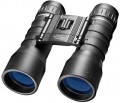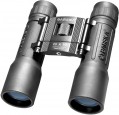Magnification
The magnification factor indicates how many times the image of any object in the eyepiece will be larger than what is visible to the naked eye. Standard values are
7x,
8x,
10x,
12x,
20x. The
higher the magnification, the greater the degree of approximation and the further the distance from which one or another object can be seen through binoculars. On the other hand, increasing the magnification usually means decreasing the angle of view, and it can be very difficult to “catch” an object of interest (especially a moving one) through binoculars. In addition, with the same lens size, a model with a higher magnification will have a smaller exit pupil size and, accordingly, a lower aperture ratio (see below for more details). For models with multiplicity adjustment (see below), this item usually indicates the maximum value of this parameter. The magnification is the first number in traditional markings like 8x40 - this example corresponds to eight-fold optics. If there is a multiplicity adjustment (see below), the markings indicate the entire range - for example, 8-12x40.
Field of view 1 km away
The diameter of the area visible through binoculars / monoculars from a distance of 1 km — in other words, the largest distance between two points at which they can be seen simultaneously from this distance. It is also called "linear field of view". Along with the angular field of view (see below), this parameter characterizes the space covered by the optics; at the same time, it describes the capabilities of a particular model more clearly than data on viewing angles. Models with magnification adjustment (see above) usually indicate the maximum field of view — at the lowest magnification and
the widest angle of view. This information is often supplemented by data on the minimum value.
Min. focus distance
The smallest distance to the observed object, at which it will be clearly visible through binoculars / monoculars. All such optical instruments were initially created for observing remote objects, therefore, not all of them are able to work at short distances. When choosing a model for this parameter, one should proceed from the expected observation conditions: ideally, the minimum focus distance should not be greater than the smallest possible distance to the observed object.
Twilight factor
A complex indicator that describes the quality of binoculars / monoculars at dusk — when the illumination is weaker than during the day, but not yet as dim as in the deep evening or at night. It is primarily about the ability to see small details through the device. The need to use this parameter is due to the fact that twilight is a special condition. In daylight, the visibility of small details through binoculars is determined primarily by the magnification of the optics, and in night light, by the diameter of the lens (see below); at dusk, both of these indicators affect the quality. This feature takes into account the twilight factor. Its specific value is calculated as the square root of the product of the multiplicity and the diameter of the lens. For example, for 8x40 binoculars, the twilight factor will be the root of 8x40=320, that is, approximately 17.8. In models with power adjustment (see above), the minimum twilight factor is usually indicated at the lowest magnification, but data is often given for the maximum. The lowest value of this parameter for normal visibility at dusk is considered to be 17. At the same time, it is worth noting that the twilight factor does not take into account the actual light transmission of the system — and it strongly depends on the quality of lenses and prisms, the use of antireflection coatings, etc. Therefore, the actual image quality at dusk for two models with the same twilight factor may differ markedly.
Relative brightness
One of the parameters describing the quality of visibility through an optical device in low light conditions. Relative brightness is denoted as the diameter of the exit pupil (see below) squared; the higher this number, the more light the binoculars/monoculars let through. At the same time, this indicator does not take into account the quality of lenses, prisms and coatings used in the design. Therefore, comparing the two models in terms of relative brightness is only possible approximately, since even if the values are equal, the actual image quality may differ markedly.
Lens diameter
The lens diameter is the front lens of the binocular/monocular. This parameter is also called "aperture". Designate it in millimetres. Aperture is one of the most important characteristics of an optical device: it describes the amount of light that the device is able to "capture" into the lens, and largely determines the image quality in low light. Therefore, the second number in the traditional marking of binoculars / monoculars is precisely the diameter of the lens — for example, 8x40 mm corresponds to 8x binoculars with an aperture of 40 mm. In addition, with a large lens it is easier to provide a wide field of view without sacrificing magnification. In general, the larger the aperture, the more advanced the optical device is considered. On the other hand, the increase in lenses has a corresponding effect on the weight and dimensions of the entire structure. And you should not forget about the influence of individual components of the system (for example, prisms) on the overall image quality.
Exit pupil diameter
The diameter of the exit pupil created by the optical system of a binocular/monocular. The exit pupil is called the projection of the front lens of the lens, built by the optics in the region of the eyepiece; this image can be observed in the form of a characteristic light circle, if you look into the eyepiece not close, but from a distance of 30 – 40 cm. The diameter of this circle is measured according to a special formula — dividing the diameter of the lens by the multiplicity (see above). For example, an 8x40 model would have a pupil diameter of 40/8=5mm. This indicator determines the overall aperture of the device and, accordingly, the image quality in low light: the larger the pupil diameter, the brighter the “picture” will be (of course, with the same quality of prisms and glasses, because they also affect the brightness). In addition, it is believed that the diameter of the exit pupil should be no less than that of the pupil of the human eye — and the size of the latter can vary. So, in daylight, the pupil in the eye has a size of 2-3 mm, and in the dark — 7-8 mm in adolescents and adults, and about 5 mm in the elderly. This point should be taken into account when choosing a model for specific conditions: after all, fast models are expensive, and it hardly makes sense to overpay for a large pupil if you need binoculars exclusively for daytime use.
Prism material
Material used for prisms found in binoculars and monoculars.
-
BK-7. A type of borosilicate optical glass (6LR61), a relatively inexpensive and at the same time quite functional material that provides, although not outstanding, quite acceptable image quality. Used in entry-level and mid-level models.
—BaK-4. Barium optical glass, noticeably superior to BK7 in brightness and image clarity, is however also more expensive. Accordingly, it is found mainly in the premium segment.

